Overview
This article presents critical strategies for the effective management of fracking water reuse. It underscores the necessity of:
- Comprehensive title research
- Cutting-edge treatment technologies
- Robust community engagement
These elements are vital for ensuring compliance, enhancing sustainability, and mitigating the environmental impacts linked to hydraulic fracturing practices.
Introduction
In the quest for sustainable energy practices, the fracking industry confronts a significant challenge: effectively managing and reusing water resources amid complex environmental regulations and community concerns. Traditional methods of water management are proving increasingly inadequate, prompting the emergence of innovative solutions. These range from advanced title research that ensures compliance with land rights to cutting-edge water treatment technologies that enhance reuse efficiency.
By exploring economic incentives and collaborative initiatives, stakeholders can not only achieve substantial cost savings but also foster public support. This article delves into the multifaceted approaches that are reshaping fracking water reuse strategies, highlighting successful case studies and future trends. It emphasizes the critical role of community engagement in creating a more sustainable energy landscape.
Harbinger Land | Advanced Title Research Solutions for Fracking Water Reuse
Harbinger Land excels in delivering advanced title research solutions that are essential for implementing fracking water reuse strategies. By meticulously recording and confirming land rights, the company empowers clients to navigate the complex legal environment associated with resource recycling. This process is especially vital, considering that a typical Marcellus well experiences an 80% decrease in fluid production within the first two years, underscoring the necessity for effective management strategies. Thorough title research uncovers potential land acquisition obstacles and ensures compliance with local laws, which is essential for the successful implementation of fracking water reuse strategies in hydraulic fracturing initiatives. In addition to conventional methods, Harbinger Land digitizes property information, enabling title agents to conduct title research and leasing efficiently and economically. By deploying imaging agents to courthouses or acquiring documents through records requests, the company can swiftly obtain large datasets as needed, streamlining the title research process and providing significant time and cost savings for clients.
Recent studies have employed data processing and modeling techniques to estimate lithium yields from produced fluids, showcasing the potential for substantial contributions to the domestic lithium supply while addressing uncertainties in the data. The use of Monte Carlo simulations to forecast cumulative produced fluid output over a decade highlights the importance of thorough title research in enhancing compliance and operational efficiency. These simulations provide critical insights that assist in aligning title research with regulatory requirements, thereby improving project compliance.
As illustrated in relevant research, estimates of lithium mass yields from produced fluids sourced from the Devonian-aged Marcellus Shale reveal the potential for resource recovery while mitigating environmental impacts. This emphasizes the necessity for comprehensive legal adherence in liquid recycling, which not only minimizes risks but also enhances project feasibility. By leveraging advanced technology and expert insights, Harbinger Land ensures that clients are well-equipped to implement effective fracking water reuse strategies. To maximize the benefits of title research solutions, land acquisition professionals should prioritize thorough documentation and proactive engagement with regulatory bodies, ultimately leading to more sustainable energy practices.
Water Treatment Technologies: Innovative Solutions for Hydraulic Fracturing Waste
Fracking water reuse strategies are being revolutionized by innovative fluid treatment technologies in the management of hydraulic fracturing waste. Techniques such as membrane filtration, advanced oxidation processes, and bioremediation are increasingly deployed to treat produced fluids with remarkable effectiveness. Notably, membrane filtration has demonstrated exceptional capability in eliminating contaminants at a molecular level, thereby making the liquid suitable for fracking water reuse strategies in various applications, including irrigation and industrial processes. Recent statistics indicate that produced fluid could account for nearly 98% of the extracted product in regions nearing depletion, underscoring the urgent need for effective processing solutions.
The financial implications of these technologies are equally significant. A cost analysis comparing alum and ferric chloride as coagulants in produced fluid processing reveals that alum results in substantially lower chemical costs and total operating expenses, positioning it as a more economical choice. This emphasizes the critical nature of selecting the appropriate treatment method, not only for environmental sustainability but also for cost efficiency, which is essential for informed land acquisition decisions.
Moreover, advancements in bioremediation technologies are enhancing the capacity to manage hydraulic fracturing waste, with innovative methods being developed to further improve quality. Environmental researchers note, "The incorporation of membrane filtration technologies not only enhances the quality of recycled liquid but also significantly reduces the ecological impact of hydraulic fracturing activities." This highlights the importance of these technologies in achieving regulatory compliance and addressing land use considerations.
As the sector continues to evolve, the integration of fracking water reuse strategies along with these pioneering fluid treatment technologies will be crucial for sustainable hydraulic fracturing practices, aligning with the demands of clients who require prompt and precise services tailored to their specific needs.
Economic Incentives: Cost-Effective Approaches to Fracking Water Reuse
Economic incentives play a pivotal role in advancing fracking water reuse strategies. By reducing dependence on new liquid sources, companies can significantly lower operational costs associated with sourcing and disposal. In 2025, numerous states are enhancing their support through tax credits and grants aimed at facilitating the adoption of recycling technologies. For example, these incentives may encompass:
- Direct financial assistance for implementing recycling systems
- Tax reductions for companies that fulfill specific sustainability criteria
This financial support not only renders it economically viable for operators to invest in sustainable practices but also cultivates a competitive advantage in the market. Companies that embrace produced fluid recycling can achieve substantial reductions in disposal fees, resulting in decreased overall management costs and enhanced profitability.
The Texas Produced Liquid Consortium, established in 2021, exemplifies collaborative efforts to assess the economic viability of produced liquid reuse. By uniting various stakeholders, the Consortium addresses legislative and practical challenges, underscoring the need for ongoing dialogue regarding produced resource ownership and utilization. The Consortium's findings highlight that effective collaboration can lead to legislative changes that bolster the financial feasibility of recycling technologies, making them more attractive to operators.
Moreover, recent proposals, such as the New Mexico governor's initiative in May 2024 to allocate USD 500 million for wastewater management, seek to create a government-supported market for treated liquid. This initiative is expected to attract private investment in desalination and treatment facilities, further improving the economic landscape for recycling within the fracking sector.
Industry leaders stress the significant cost savings associated with recycling technologies. As Kelly Bennett, Chief Executive Officer and Co-Founder, noted, "Thanks to recycling, the quantity of fresh and brackish liquid utilized in Permian completions in 2030 will be 500,000 barrels per day less than in 2017, despite the basin’s oil production increasing more than 325% over the same period." Such statistics underscore the economic benefits of fracking water reuse strategies, establishing them as a compelling approach for operators seeking to enhance both sustainability and profitability.
Environmental Strategies: Reducing the Impact of Fracking Waste Water
Implementing effective fracking water reuse strategies is crucial for mitigating the impact of drilling wastewater. Closed-loop systems, which enable on-site fluid recycling, have been shown to significantly lower wastewater volumes, and the implementation of fracking water reuse strategies can lead to a reduction of up to 90% in wastewater generation. The adoption of non-toxic additives during the extraction process further minimizes contamination risks, promoting safer practices.
Businesses are increasingly exploring fracking water reuse strategies for irrigation and other non-drinkable purposes. This approach not only conserves fresh resources but also mitigates the ecological impact associated with fracking water reuse strategies for wastewater disposal. Recent advancements in closed-loop systems illustrate their successful implementation across various operations, particularly in fracking water reuse strategies, highlighting their benefits in enhancing sustainability and operational efficiency.
Expert insights suggest that integrating fracking water reuse strategies can lead to more responsible resource management and improved community relations, especially in lower-resourced regions disproportionately affected by drilling activities. As Taylor Brorby poignantly states, "I wanted to be that open with others. Be able to express myself without fear. Spare emotions fester in a landscape where the only way capitalism has made sense of the American West is to fence it in." This underscores the necessity for a more thoughtful approach to resource management.
The One Health Initiative serves as a model for collaboration, advocating for interdisciplinary partnerships to address the broader environmental and public health concerns associated with unconventional oil and gas development (UOGD). To further enhance these strategies, companies should engage with local communities to understand their concerns and incorporate their feedback into operational practices, fostering a more inclusive approach to environmental stewardship.
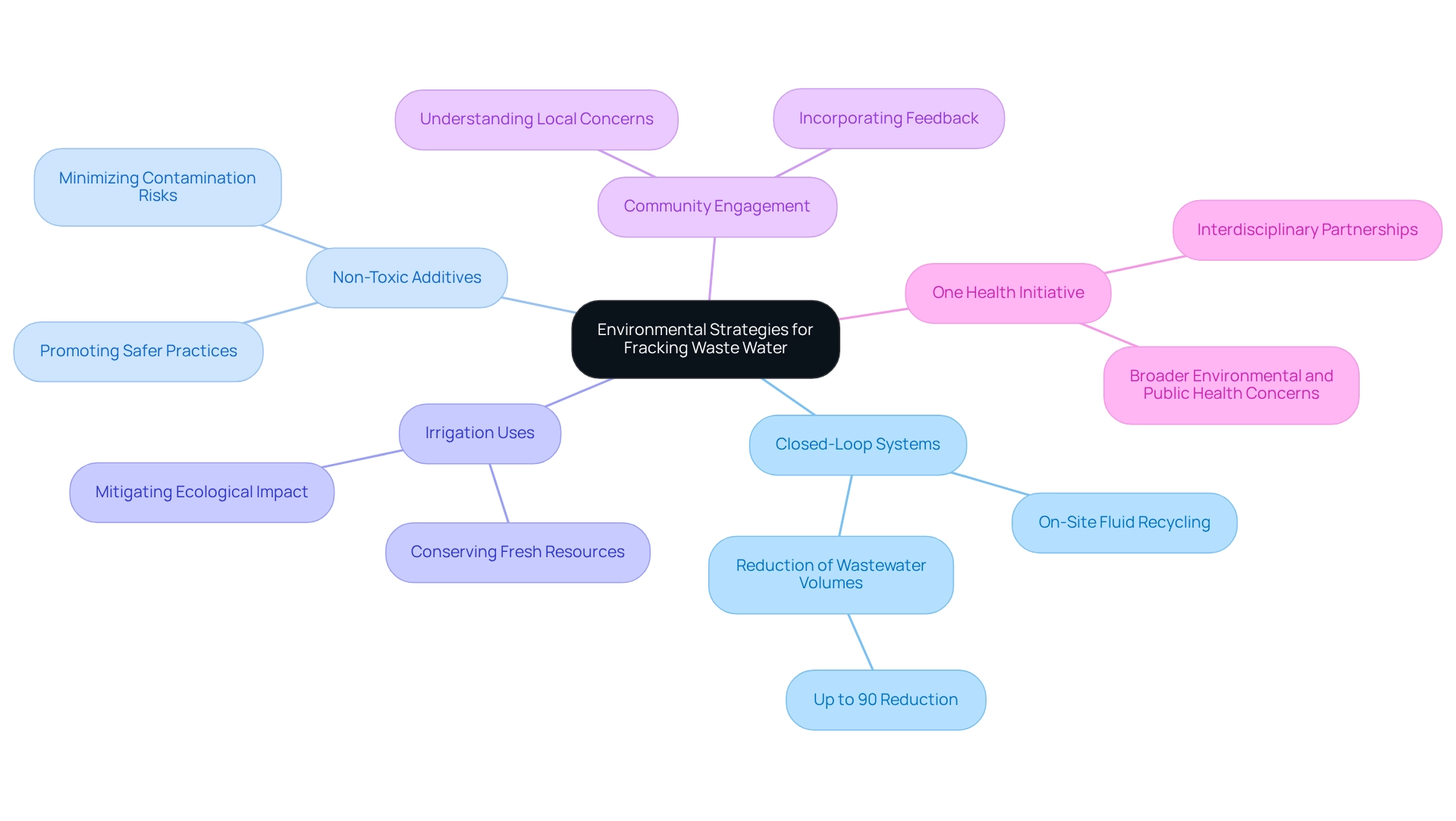
Regulatory Frameworks: Navigating Laws for Fracking Water Reuse
Navigating the regulatory frameworks surrounding fracking water reuse strategies is crucial for ensuring compliance and operational success. In 2025, various federal and state regulations govern the handling and reuse of produced liquid. The EPA has established comprehensive guidelines for wastewater management, which serve as a baseline for compliance. Additionally, state agencies often impose further requirements that companies must adhere to, reflecting the unique environmental and economic contexts of each region.
For instance, the 'Oil and Gas Produced Water and Waste Recycling and Reuse Act,' signed into law in Oklahoma in 2020, exemplifies the evolving regulatory landscape. As Governor Kevin Stitt stated, "This legislation emphasizes the importance of recycling and reusing produced fluids, aligning with broader sustainability goals." Similarly, in Texas, the handling of produced fluid is governed by the Oil and Gas Extraction Point Source Category, emphasizing the state's dedication to accountable resource management.
Expert opinions underscore the necessity for companies to remain vigilant about these regulations. Legal experts emphasize that understanding EPA guidelines and state-specific requirements is essential for avoiding fines and operational disruptions. Effective compliance strategies frequently include proactive interaction with regulatory agencies and investment in advanced technology solutions.
A notable case study involves a public-private research consortium formed in New Mexico, which includes major energy companies like Chevron and ExxonMobil. This initiative, originating from 2019 state legislation, seeks to offer clear guidance for industry investment in treatment technologies, ensuring sustainable practices that tackle scarcity while fostering economic growth. Such collaborations demonstrate the potential for industry stakeholders to navigate complex regulatory frameworks effectively, fostering innovation in liquid repurposing practices. The necessity for thorough regulations for produced liquid management and recycling, particularly fracking water reuse strategies, is essential, as it guarantees that all parties are united in their endeavors to encourage sustainability and adherence.
Collaborative Initiatives: Partnerships for Effective Fracking Water Management
Joint efforts among oil and gas firms, regional authorities, and ecological groups are essential for the effective management of fracking fluids. These collaborations enable stakeholders to pool resources, share knowledge, and implement best practices, ultimately leading to more sustainable fracking water reuse strategies. As Gina McCarthy, Administrator for the U.S. Environmental Protection Agency, noted, "At its core, the issue of a clean environment is a matter of public health." This statement underscores the critical importance of sustainable practices within the industry.
For instance, the establishment of regional liquid recycling facilities can be part of fracking water reuse strategies, benefiting multiple operators by significantly reducing costs and minimizing environmental impacts. The U.S. has the potential to eliminate its oil imports by 2040 and completely eradicate oil consumption by 2050, highlighting the urgent need for effective resource management strategies. Such collaborations not only improve operational efficiency but also enhance community engagement, ensuring that local concerns are addressed.
A prominent example is Boyan Slat's initiative, The Ocean Cleanup, which illustrates how innovative solutions can tackle environmental challenges. As the sector continues to evolve, the importance of these collaborations will only grow, fostering innovation and promoting responsible resource management practices.
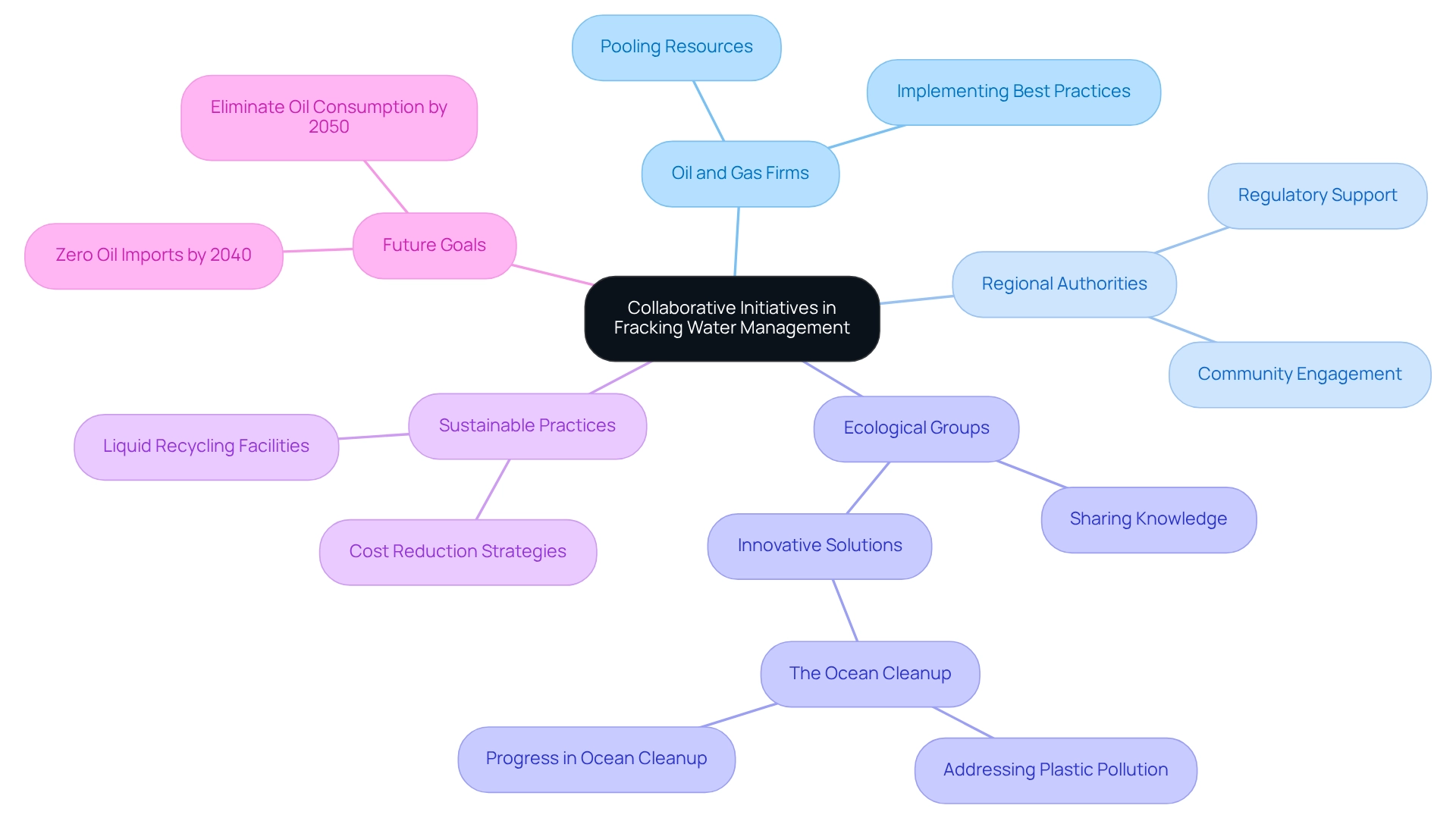
Technological Innovations: Cutting-Edge Water Recycling Systems for Fracking
Technological advancements are revolutionizing fracking water reuse strategies within recycling systems in fracking activities, prominently featuring mobile purification units and automated monitoring technologies. These sophisticated systems facilitate real-time evaluation and management of liquid quality, significantly boosting operational efficiency. Techniques such as electrocoagulation and advanced filtration are increasingly being embraced, further enhancing purification processes. Importantly, these innovations not only support the recycling of generated liquids but also ensure compliance with safety standards for fracking water reuse strategies across a variety of applications.
As the hydraulic fracturing fluid processing systems market is projected to grow at a CAGR of 4.24% from 2023 to 2032, the integration of these advanced technologies is crucial for meeting the evolving demands of the sector. The improvements in liquid purification efficiency play a vital role in strategic planning for land acquisition, influencing site selection and regulatory compliance. The effective implementation of mobile liquid treatment units, as demonstrated in recent drilling projects, has proven invaluable in enhancing fracking water reuse strategies. This highlights the potential for increased activities in emerging markets, underscoring the need for industry stakeholders to adapt to these advancements.
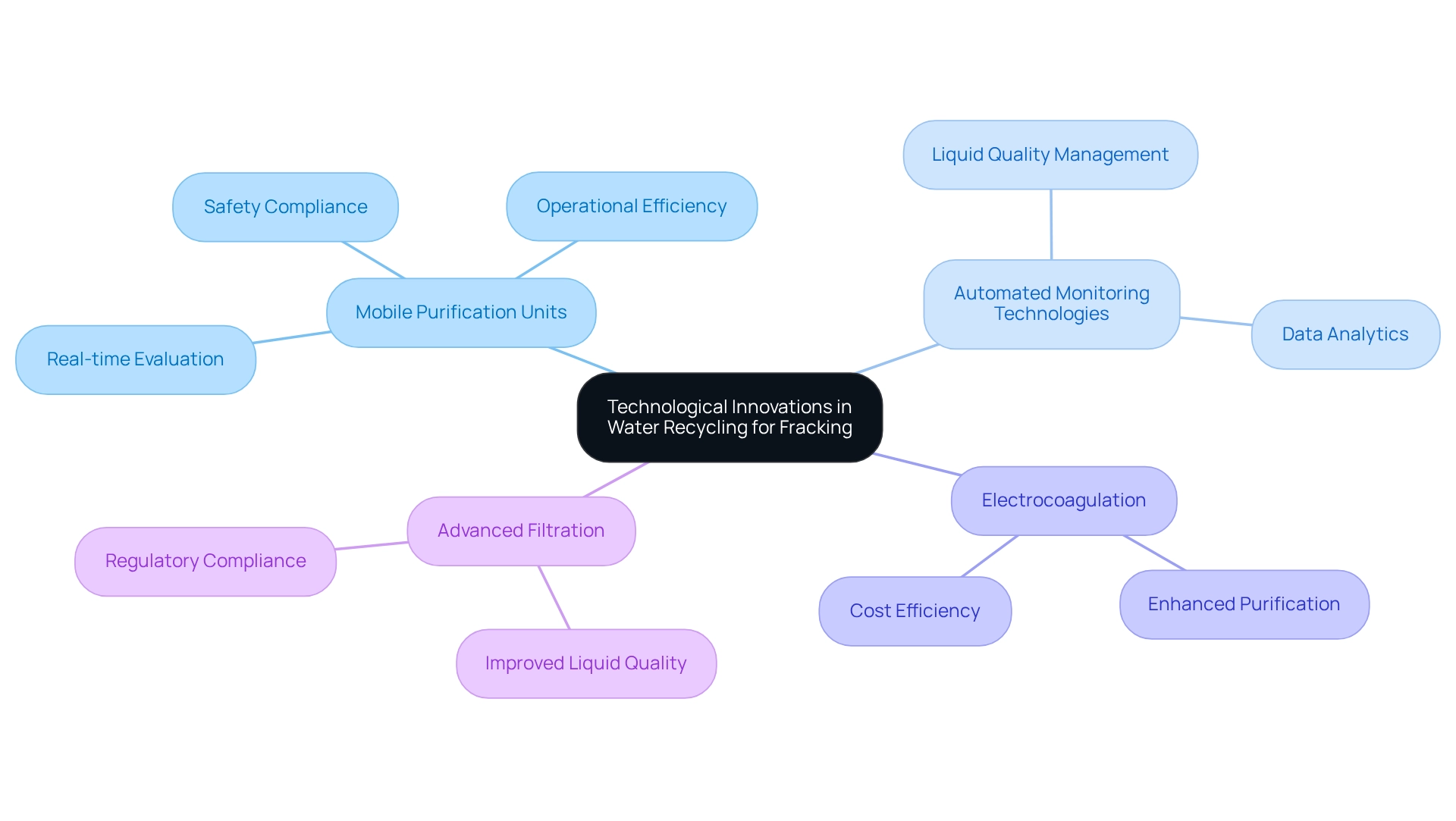
Case Studies: Successful Fracking Water Reuse Projects in Action
Numerous successful case studies underscore the effectiveness of fracking water reuse strategies. A notable project in Texas established a closed-loop recycling system that achieved an impressive 50% reduction in freshwater usage while maintaining operational efficiency. This innovative method not only conserves essential fluid resources but also significantly lowers operational expenses, as the cost of a barrel of oil-based mud in the area can reach approximately $175. As Ira Yates, a member of the Produced Water Society, aptly stated, "If we can land a rocket on a platform in the middle of the ocean, we can clean up fluids," highlighting the capabilities of modern management technologies.
In New Mexico, another compelling example involved utilizing treated produced liquid for agricultural irrigation, illustrating the potential for collaboration between the energy sector and agriculture. Daniel Timmons from WildEarth Guardians advocates for more economical strategies to address scarcity, such as assisting farmers in transitioning to less resource-intensive crops. This initiative not only addresses resource scarcity but also promotes sustainable practices across industries.
These case studies demonstrate the crucial role of fracking water reuse strategies as innovative resource management solutions in enhancing both environmental sustainability and economic viability in fracking operations. As emphasized by industry specialists, the adoption of closed-loop systems can lead to significant improvements in conservation efforts, paving the way for a more responsible approach to resource management in the energy sector. However, as Zacariah Hildenbrand from the University of Texas, El Paso, noted, there is a lack of robust regulations for the advantageous repurposing of resources, which presents both challenges and opportunities for the industry.
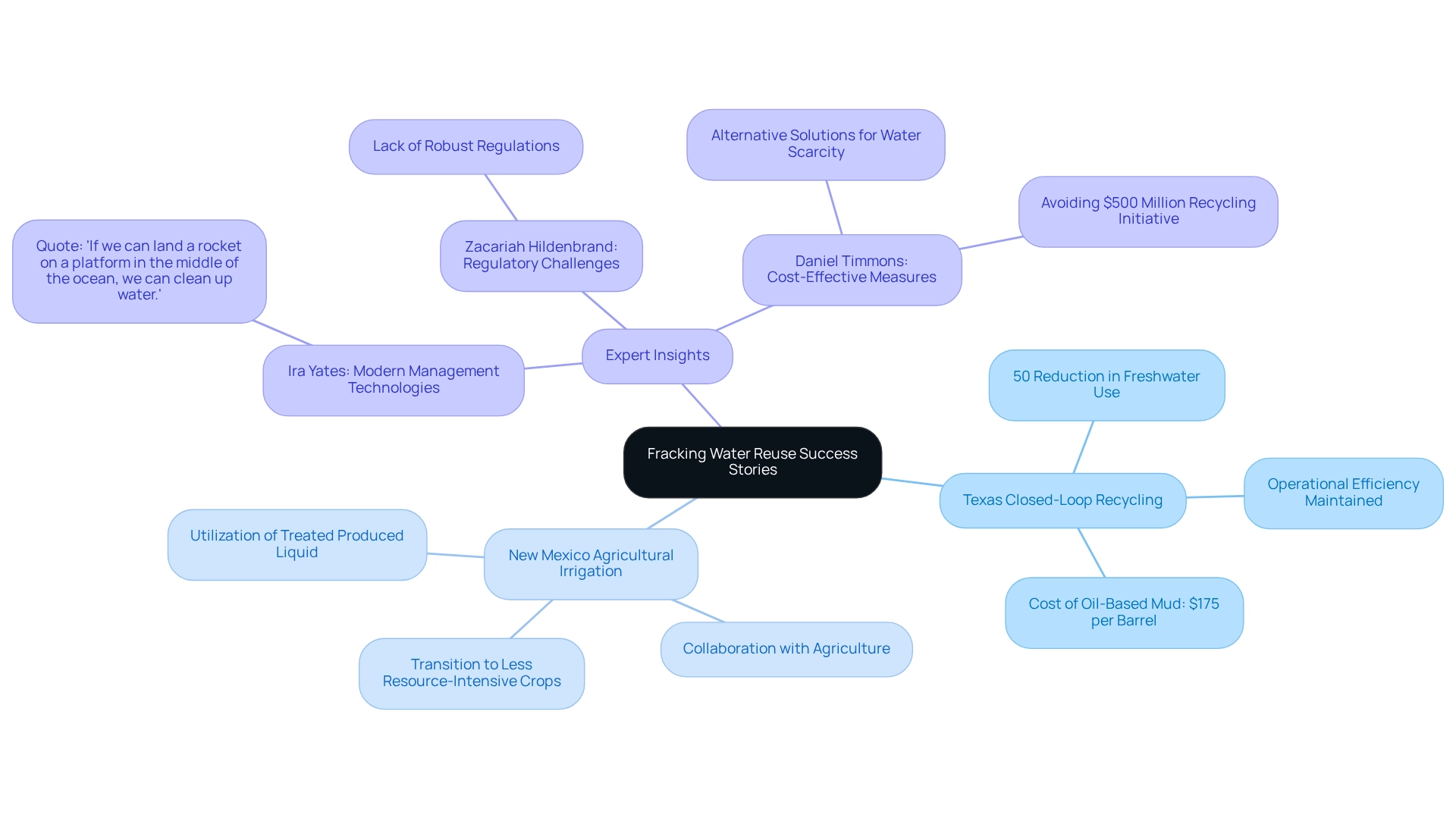
Community Engagement: Building Public Support for Fracking Water Reuse
Community involvement is essential in garnering public support for fracking water reuse strategies. Businesses must actively communicate the advantages of fracking water reuse strategies, particularly their potential to mitigate environmental impacts and bolster resource security. Mark White, Vice President and Drinking Supply Practice Leader, asserts that effective resource management solutions are vital for building community trust. His extensive experience in liquid treatment, including overseeing membrane filtration treatment capacity exceeding 400 million gallons per day, underscores the significance of these initiatives.
Strategic approaches include:
- Hosting public forums to foster open dialogue
- Providing transparent insights into liquid treatment processes
- Directly addressing community concerns
By engaging local stakeholders in decision-making, companies not only improve project acceptance but also contribute to more sustainable outcomes. Statistics demonstrate that initiatives with strong community engagement experience markedly higher levels of public support, highlighting the critical nature of these efforts. Successful case studies, such as the collaboration of Steve Via with the EPA on policy, illustrate that when communities feel recognized and informed, trust is cultivated, laying the groundwork for effective resource management projects. Kelley Dearing Smith, Vice President of Communications and Marketing, emphasizes that visionary leadership and compelling storytelling are pivotal in fostering public trust in recycling initiatives. By integrating these elements, businesses can create a supportive environment for recycling projects that utilize fracking water reuse strategies.
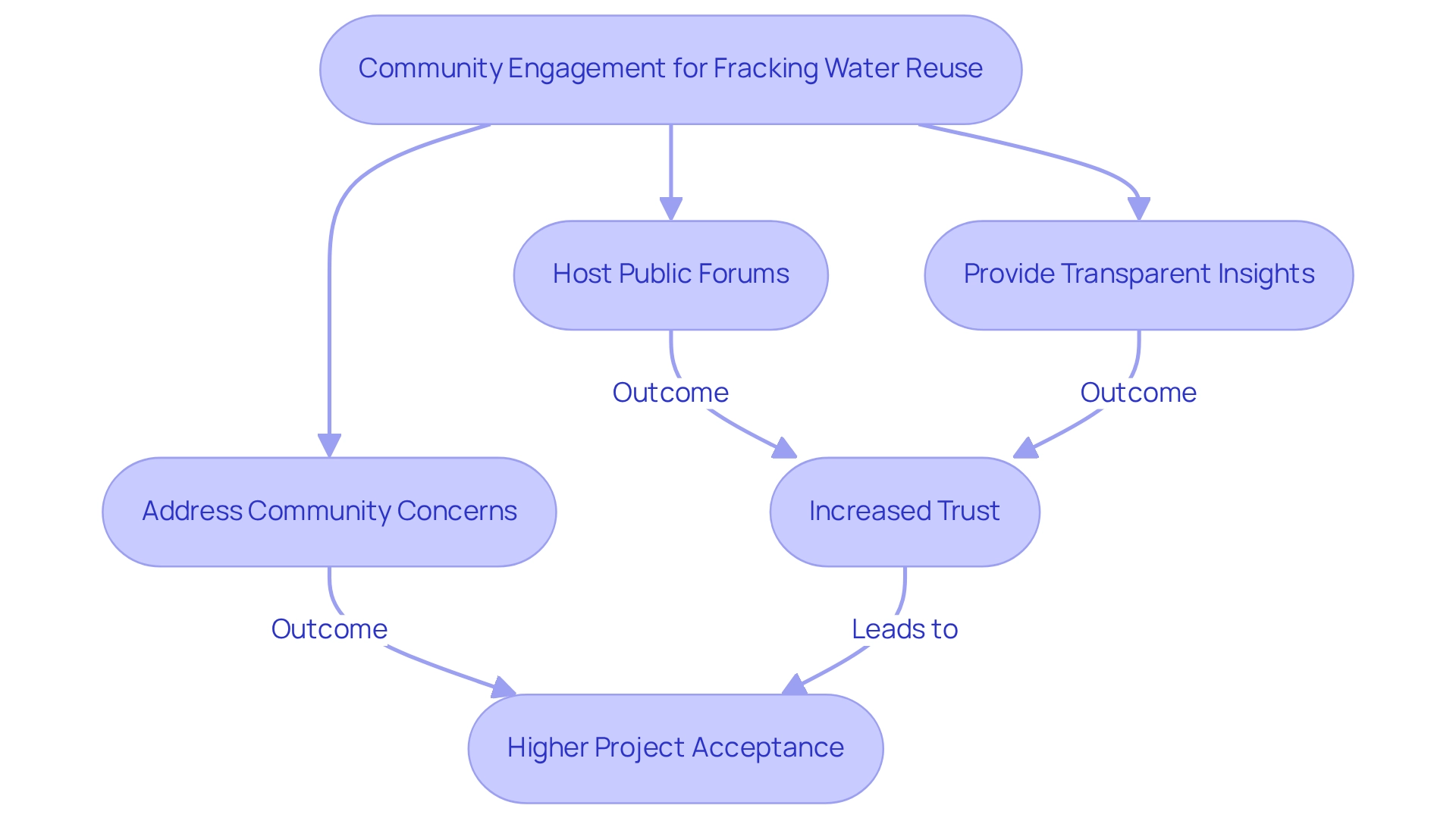
Future Trends: The Evolution of Fracking Water Reuse Strategies
The future of fracking water reuse strategies is on the brink of transformative changes, primarily driven by advancements in technology and evolving regulatory frameworks. Key trends include:
- The automation of liquid treatment processes, streamlining operations and minimizing human error.
- The integration of artificial intelligence (AI) for real-time monitoring of liquid quality, empowering operators to make data-driven decisions that enhance operational efficiency and environmental compliance.
- A transition towards more efficient recycling systems, with an emphasis on sustainable practices propelled by increasing public awareness of resource scarcity and environmental issues.
This commitment to addressing contemporary environmental challenges is crucial for the industry's long-term viability.
Moreover, the adoption of AI and machine learning technologies is vital for achieving sustainability in the oil and gas sector. These innovations not only improve the precision of quality evaluations but also facilitate proactive resource management. For instance, a recent case study on the adaptive multi-task adjustment of surface equipment in fracturing underscored the potential of wireless intelligent gateways and cloud-based monitoring systems to enhance operational control and efficiency. This case also highlights the operational inefficiencies and risks associated with manual diagnostics and adjustments, which can pose significant challenges in fracturing operations.
Looking ahead, the emphasis on community participation in resource management decisions is expected to increase, fostering collaboration between industry stakeholders and local populations. This shift towards transparency and engagement is anticipated to further enhance the sustainability of hydraulic fracturing operations. As Emran Alotaibi from Khalifa University of Science and Technology noted, "Continuous research, innovation, and collaboration will be essential to unlock the full potential of these technologies and contribute to the creation of a more sustainable and environmentally resilient future."
As these trends develop, the sector will witness a notable transformation in approaches for resource repurposing, ultimately aiding in a more resilient energy future. Furthermore, the thematic map categorizing research into Motor Themes, Niche Themes, Basic Themes, and Emerging or Declining Themes provides a structured understanding of the current research landscape in fracking water reuse strategies, highlighting the importance of ongoing innovation and adaptation.
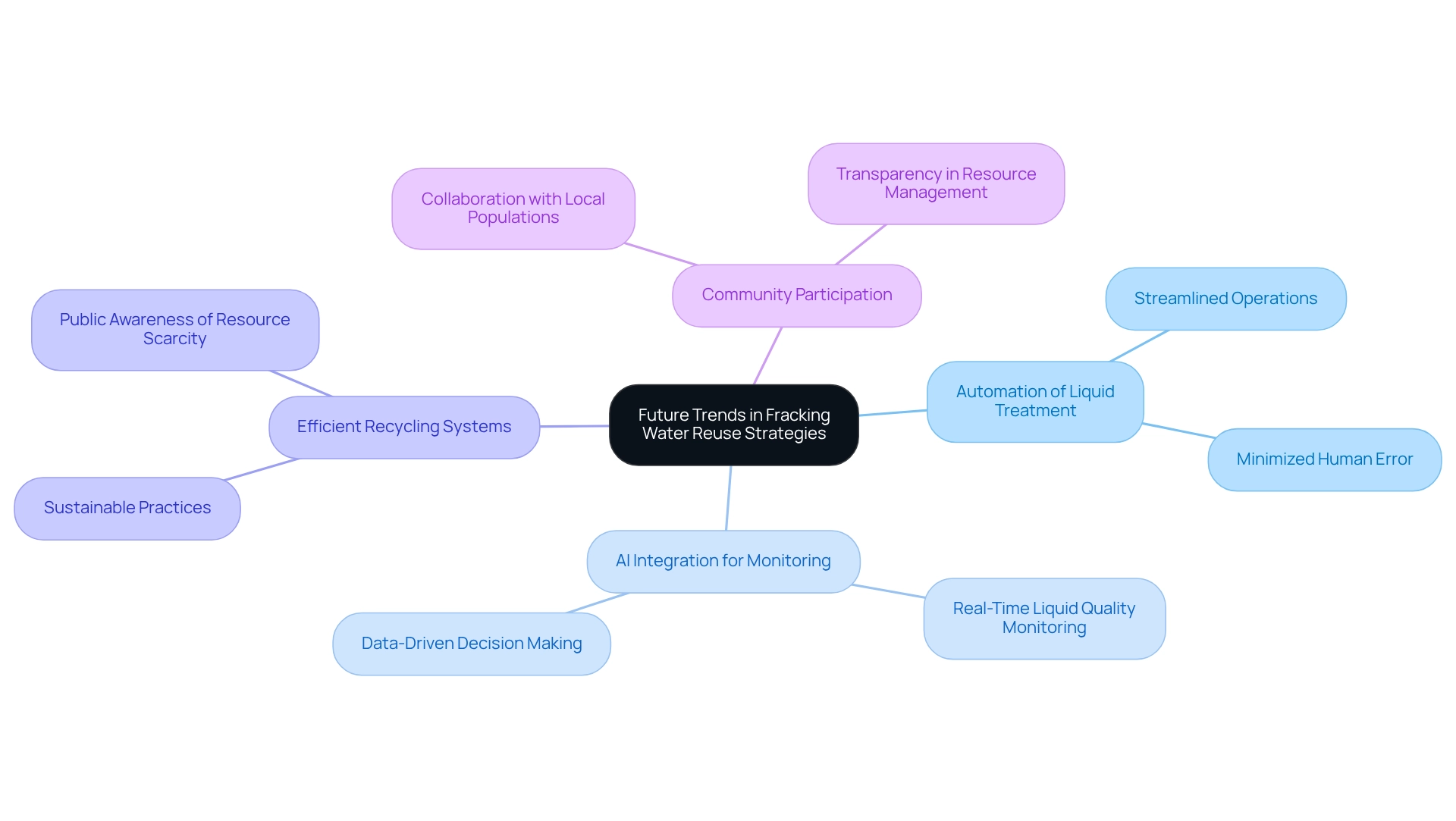
Conclusion
The exploration of innovative fracking water reuse strategies reveals a multifaceted approach essential for addressing operational efficiency and environmental sustainability. Advanced title research solutions provided by companies like Harbinger Land, alongside cutting-edge water treatment technologies, illustrate the industry's evolution in meeting regulatory compliance and community expectations. By integrating economic incentives and collaborative initiatives, stakeholders can achieve significant cost savings while promoting responsible resource management.
Successful case studies showcase the tangible benefits of these strategies. Closed-loop systems and the use of treated produced water for agricultural purposes significantly reduce freshwater consumption while enhancing operational effectiveness. Community engagement emerges as a critical factor, emphasizing the need for transparent communication and stakeholder involvement to build public trust and support for fracking water reuse initiatives.
Looking ahead, the future of fracking water reuse is poised for transformative changes driven by technological advancements and heightened regulatory frameworks. The integration of artificial intelligence and automation in water treatment processes will enhance efficiency and compliance. Ongoing collaboration between industry players and local communities will foster sustainable practices. As the industry navigates these changes, the commitment to innovative solutions and responsible water management will be crucial for ensuring a resilient energy landscape that benefits both the environment and society at large.
Frequently Asked Questions
What services does Harbinger Land provide related to fracking water reuse strategies?
Harbinger Land delivers advanced title research solutions that help clients navigate the complex legal environment associated with resource recycling, ensuring compliance with local laws and uncovering potential land acquisition obstacles.
Why is title research important in the context of fracking water reuse?
Title research is essential because it helps identify legal land rights and compliance issues, which are critical for the successful implementation of fracking water reuse strategies, especially given the rapid decrease in fluid production from wells.
How does Harbinger Land enhance the title research process?
The company digitizes property information and employs imaging agents to obtain large datasets efficiently, streamlining the title research process and providing significant time and cost savings for clients.
What role do data processing and modeling techniques play in estimating lithium yields from produced fluids?
These techniques, including Monte Carlo simulations, assist in forecasting cumulative produced fluid output and improving compliance and operational efficiency, thereby aligning title research with regulatory requirements.
What advancements are being made in fluid treatment technologies for hydraulic fracturing waste?
Innovative technologies such as membrane filtration, advanced oxidation processes, and bioremediation are being utilized to treat produced fluids effectively, making them suitable for reuse in various applications.
What financial implications do treatment technologies have for fracking water reuse?
Cost analyses show that certain treatment methods, like alum as a coagulant, lead to lower chemical costs and total operating expenses, emphasizing the need for economically viable treatment choices.
How do economic incentives support fracking water reuse strategies?
States are enhancing support through tax credits and grants for recycling technologies, making it economically viable for operators to invest in sustainable practices and reducing overall management costs.
What collaborative efforts are being made to assess the economic viability of produced liquid reuse?
The Texas Produced Liquid Consortium was established to address legislative and practical challenges regarding produced resource ownership and utilization, highlighting the importance of ongoing dialogue.
What recent initiatives aim to improve the economic landscape for recycling in the fracking sector?
Initiatives like the New Mexico governor's proposal to allocate USD 500 million for wastewater management aim to create a government-supported market for treated liquid, attracting private investment in treatment facilities.
What are the projected benefits of recycling technologies in the fracking industry?
Industry leaders indicate that recycling technologies can lead to significant cost savings and reduced dependence on fresh liquid sources, enhancing both sustainability and profitability for operators.
List of Sources
- Harbinger Land | Advanced Title Research Solutions for Fracking Water Reuse
- Estimates of lithium mass yields from produced water sourced from the Devonian-aged Marcellus Shale - Scientific Reports (https://nature.com/articles/s41598-024-58887-x)
- Water Treatment Technologies: Innovative Solutions for Hydraulic Fracturing Waste
- Frontiers | The Role of Membrane-Based Technologies in Environmental Treatment and Reuse of Produced Water (https://frontiersin.org/journals/environmental-science/articles/10.3389/fenvs.2021.629767/full)
- Treatment of Produced Water in the Permian Basin for Hydraulic Fracturing: Comparison of Different Coagulation Processes and Innovative Filter Media (https://mdpi.com/2073-4441/12/3/770)
- Advances in Produced Water Treatment Technologies: An In-Depth Exploration with an Emphasis on Membrane-Based Systems and Future Perspectives (https://mdpi.com/2073-4441/15/16/2980)
- Document Display | NEPIS | US EPA (https://nepis.epa.gov/Exe/ZyPURL.cgi?Dockey=P100QSBM.TXT)
- Economic Incentives: Cost-Effective Approaches to Fracking Water Reuse
- Fracking Water Treatment Market Size | Mordor Intelligence (https://mordorintelligence.com/industry-reports/fracking-water-treatment-market)
- Mine: All Mine? Texas Ownership of Produced Water and Its Constituent Parts (Lithium) – Jackson Walker (https://jw.com/news/texas-produced-water-ownership)
- Water Conservation In Oil And Gas Operations | Colorado General Assembly (https://leg.colorado.gov/bills/hb23-1242)
- Permian Embraces Produced Water Recycling (https://aogr.com/magazine/frac-facts/permian-embraces-produced-water-recycling)
- Environmental Strategies: Reducing the Impact of Fracking Waste Water
- Integrated effort needed to mitigate fracking while protecting both humans and the environment (https://ysph.yale.edu/news-article/integrated-effort-needed-to-mitigate-fracking-while-protecting-both-humans-and-the-environment)
- Fracking Quotes (10 quotes) (https://goodreads.com/quotes/tag/fracking)
- Quotable Fracking Quotes (https://conservationcouncil.ca/quotable-fracking-quotes)
- Regulatory Frameworks: Navigating Laws for Fracking Water Reuse
- Analysis of Regulatory Framework for Produced Water Management and Reuse in Major Oil- and Gas-Producing Regions in the United States (https://mdpi.com/2073-4441/14/14/2162)
- New Mexico officials propose regulations for reuse of fracking wastewater (https://foxnews.com/us/new-mexico-officials-propose-regulations-reuse-fracking-wastewater)
- Collaborative Initiatives: Partnerships for Effective Fracking Water Management
- community.element14.com (https://community.element14.com/technologies/businessofengineering/b/blog/posts/12-quotes-from-12-inspiring-engineers-and-activists---now-is-the-time-for-climate-action)
- 12 Recycling and Sustainability Quotes to Inspire Kindness to our Earth (https://harmony1.com/recycling-sustainability-quotes)
- 6 Quotes About Water Pollution to Inspire Sustainable Industrial Practices (https://chemtech-us.com/6-quotes-about-water-pollution-to-inspire-sustainable-industrial-practices)
- Technological Innovations: Cutting-Edge Water Recycling Systems for Fracking
- Fracking Water Treatment Systems Market Size & Share 2032 (https://globalmarketstatistics.com/market-reports/fracking-water-treatment-systems-market-12147)
- New Solutions Emerge To Treat & Recycle Water Used In Hydraulic Fracs (https://aogr.com/magazine/cover-story/new-solutions-emerging-to-treat-and-recycle-water-used-in-hydraulic-fracs)
- Advances in Produced Water Treatment Technologies: An In-Depth Exploration with an Emphasis on Membrane-Based Systems and Future Perspectives (https://mdpi.com/2073-4441/15/16/2980)
- Case Studies: Successful Fracking Water Reuse Projects in Action
- To ease looming West Texas water shortage, oil companies have begun recycling fracking wastewater (https://texastribune.org/2022/12/19/texas-permian-basin-fracking-oil-wastewater-recycling)
- New Mexico wants to recycle fracking wastewater for clean energy. Who stands to gain? (https://news.oilandgaswatch.org/post/new-mexico-wants-to-recycle-fracking-wastewater-for-clean-energy-who-stands-to-gain)
- Closed-Loop Systems Provide Win-Win Benefits In Horizontal Shale Plays (https://aogr.com/magazine/editors-choice/closed-loop-systems-provide-win-win-benefits)
- Community Engagement: Building Public Support for Fracking Water Reuse
- From Rules to Solutions: LCRI, PFAS, and Community Impact (https://awwa.org/event/from-rules-to-solutions-lcri-pfas-and-community-impact)
- Future Trends: The Evolution of Fracking Water Reuse Strategies
- Artificial intelligence in environmental monitoring: in-depth analysis - Discover Artificial Intelligence (https://link.springer.com/article/10.1007/s44163-024-00198-1)
- Sustainable water management in the oil and gas industry: Harnessing the power of AI and data-driven solutions for efficient water use | Amazon Web Services (https://aws.amazon.com/blogs/industries/sustainable-water-management-in-the-oil-and-gas-industry-harnessing-the-power-of-ai-and-data-driven-solutions-for-efficient-water-use)
- Intelligent hydraulic fracturing under industry 4.0—a survey and future directions - Journal of Petroleum Exploration and Production Technology (https://link.springer.com/article/10.1007/s13202-024-01877-6)




